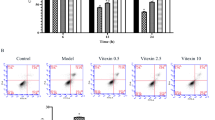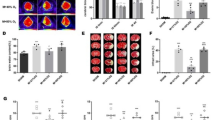Abstract
Cerebral infarction (CI) is a common clinical cerebrovascular disease, and to explore the pathophysiological mechanisms and seek effective treatment means are the hotspot and difficult point in medical research nowadays. Numerous studies have confirmed that uric acid plays an important role in CI, but the mechanism has not yet been clarified. When treating HT22 and BV-2 cells with different concentrations of uric acid, uric acid below 450 μM does not have significant effect on cell viability, but uric acid more than 500 μM can significantly inhibit cell viability. After establishing models of OGD (oxygen-glucose deprivation) with HT22 and BV-2 cells, uric acid at a low concentration (50 μM) cannot improve cell viability and apoptosis, and Reactive oxygen species (ROS) levels during OGD/reoxygenation; a suitable concentration (300 μM) of uric acid can significantly improve cell viability and apoptosis, and reduce ROS production during OGD/reoxygenation; but a high concentration (1000 μM) of uric acid can further reduce cell viability and enhance ROS production. After establishing middle cerebral artery occlusion of male rats with suture method, damage and increase of ROS production in brain tissue could be seen, and after adding suitable concentration of uric acid, the degree of brain damage and ROS production was reduced. Therefore, different concentrations of uric acid should have different effect, and suitable concentrations of uric acid have neuroprotective effect, and this finding may provide guidance for study on the clinical curative effect of uric acid.




Similar content being viewed by others
References
Amaro S, Soy D, Obach V, Cervera A, Planas AM, Chamorro A (2007) A pilot study of dual treatment with recombinant tissue plasminogen activator and uric acid in acute ischemic stroke. Stroke 38(7):2173–2175
Amaro S, Planas AM, Chamorro A (2008) Uric acid administration in patients with acute stroke: a novel approach to neuroprotection. Expert Rev Neurother 8(2):259–270
Amaro S, Obach V, Cervera A, Urra X, Gómez-Choco M, Planas AM, Chamorro A (2009) Course of matrix metalloproteinase-9 isoforms after the administration of uric acid in patients with acute stroke: a proof-of-concept study. J Neurol 256(4):651–656
Amaro S, Cánovas D, Castellanos M, Gállego J, Martí-Fèbregas J, Segura T, Chamorro A (2010) The URICO-ICTUS study, a phase 3 study of combined treatment with uric acid and rtPA administered intravenously in acute ischaemic stroke patients within the first 4.5 h of onset of symptoms. Int J Stroke 5(4):325–328
Amaro S, Urra X, Gómez-Choco M, Obach V, Cervera A, Vargas M, Torres F, Rios J, Planas AM, Chamorro A (2011) Uric acid levels are relevant in patients with stroke treated with thrombolysis. Stroke 42(1 Suppl):S28–S32
Amaro S, Llull L, Renú A, Laredo C, Perez B, Vila E, Torres F, Planas AM, Chamorro Á (2015) Uric acid improves glucose-driven oxidative stress in human ischemic stroke. Ann Neurol 77(5):775–783
Brouns R, Wauters A, Van De Vijver G, De Surgeloose D, Sheorajpanday R, De Deyn PP (2010) Decrease in uric acid in acute ischemic stroke correlates with stroke severity, evolution and outcome. Clin Chem Lab Med 48(3):383–390
Cadilhac DA, Kim J, Lannin NA, Kapral MK, Schwamm LH, Dennis MS, Norrving B, Meretoja A (2016) National stroke registries for monitoring and improving the quality of hospital care: a systematic review. Int J Stroke 11(1):28–40
Candelario-Jalil E (2009) Injury and repair mechanisms in ischemic stroke: considerations for the development of novel neurotherapeutics. Curr Opin Investig Drugs 10(7):644–654
Chamorro A, Obach V, Cervera A, Revilla M, Deulofeu R, Aponte JH (2002) Prognostic significance of uric acid serum concentration in patients with acute ischemic stroke. Stroke 33(4):1048–1052
Chamorro A, Amaro S, Castellanos M, Segura T, Arenillas J, Martí-Fábregas J, Gállego J, Krupinski J et al (2014) Safety and efficacy of uric acid in patients with acute stroke (URICO-ICTUS): a randomised, double-blind phase 2b/3 trial. Lancet Neurol 13(5):453–460
Conforti-Andreoni C, Spreafico R, Qian HL, Riteau N, Ryffel B, Ricciardi-Castagnoli P, Mortellaro A (2011) Uric acid-driven Th17 differentiation requires inflammasome-derived IL-1 and IL-18. J Immunol 187(11):5842–5850
Corry DB, Eslami P, Yamamoto K, Nyby MD, Makino H, Tuck ML (2008) Uric acid stimulates vascular smooth muscle cell proliferation and oxidative stress via the vascular renin-angiotensin system. J Hypertens 26(2):269–275
Crişan TO, Cleophas MC, Oosting M, Lemmers H, Toenhake-Dijkstra H, Netea MG, Jansen TL, Joosten LA (2016) Soluble uric acid primes TLR-induced proinflammatory cytokine production by human primary cells via inhibition of IL-1Ra. Ann Rheum Dis 75(4):755–762
Heo SH, Lee SH (2010) High levels of serum uric acid are associated with silent brain infarction. J Neurol Sci 297(1–2):6–10
Hozawa A, Folsom AR, Ibrahim H, Nieto FJ, Rosamond WD, Shahar E (2006) Serum uric acid and risk of ischemic stroke: the ARIC study. Atherosclerosis 187(2):401–407
Huang J, Hu D, Wang Y, Zhang D, Qu Y (2014) Dose-response relationship of serum uric acid levels with risk of stroke mortality. Atherosclerosis 234(1):1–3
Kahles T, Brandes RP (2012) NADPH oxidases as therapeutic targets in ischemic stroke. Cell Mol Life Sci 69(14):2345–2363
Li R, Huang C, Chen J, Guo Y, Tan S (2015) The role of uric acid as a potential neuroprotectant in acute ischemic stroke: a review of literature. Neurol Sci 36(7):1097–1103
Liu X, Liu M, Chen M, Ge QM, Pan SM (2015) Serum uric acid is neuroprotective in Chinese patients with acute ischemic stroke treated with intravenous recombinant tissue plasminogen activator. J Stroke Cerebrovasc Dis 24(5):1080–1086
Llull L, Laredo C, Renú A, Pérez B, Vila E, Obach V, Urra X, Planas A, Amaro S, Chamorro Á (2015) Uric acid therapy improves clinical outcome in women with acute ischemic stroke. Stroke 46(8):2162–2167
Romanos E, Planas AM, Amaro S, Chamorro A (2007) Uric acid reduces brain damage and improves the benefits of rt-PA in a rat model of thromboembolic stroke. J Cereb Blood Flow Metab 27(1):14–20
Seet RC, Kasiman K, Gruber J, Tang SY, Wong MC, Chang HM, Chan YH, Halliwell B, Chen CP (2010) Is uric acid protective or deleterious in acute ischemic stroke? A prospective cohort study. Atherosclerosis 209(1):215–219
Wang Z, Lin Y, Liu Y, Chen Y, Wang B, Li C, Yan S, Wang Y, Zhao W (2016) Serum uric acid levels and outcomes after acute ischemic stroke. Mol Neurobiol 53(3):1753–1759
Weir CJ, Muir SW, Walters MR, Lees KR (2003) Serum urate as an independent predictor of poor outcome and future vascular events after acute stroke. Stroke 34(8):1951–1956
Wu H, Jia Q, Liu G, Liu L, Pu Y, Zhao X, Wang C, Wang Y (2014) Decreased uric acid levels correlate with poor outcomes in acute ischemic stroke patients, but not in cerebral hemorrhage patients. J Stroke Cerebrovasc Dis 23(3):469–475
Yu ZF, Bruce-Keller AJ, Goodman Y, Mattson MP (1998) Uric acid protects neurons against excitotoxic and metabolic insults in cell culture, and against focal ischemic brain injury in vivo. J Neurosci Res 53(5):613–625
Zhang B, Gao C, Yang N, Zhang W, Song X, Yin J, Pu S, Yi Y, Gao Q (2010) Is elevated SUA associated with a worse outcome in young Chinese patients with acute cerebral ischemic stroke? BMC Neurol 10:82
Acknowledgments
This work was supported by the Natural Science Foundation of Guangdong Province (2016A030313609), the Medical Scientific Research Foundation of Guangdong Province (A2016199) and the Science and Technology Plan Project of Guangdong Province (2015A030302091).
Authors’ Contributions
BZ and NY designed and conducted most of the experiments. SPL and FZ designed and conducted some of the experiments. BZ and NY wrote most of the manuscript. All authors analyzed the data, revised the manuscript, and approved the final manuscript.
Author information
Authors and Affiliations
Corresponding author
Ethics declarations
Conflict of Interest
The authors declare no conflict of interest.
Additional information
Bin Zhang and Ning Yang have contributed equally to this work.
Rights and permissions
About this article
Cite this article
Zhang, B., Yang, N., Lin, Sp. et al. Suitable Concentrations of Uric Acid Can Reduce Cell Death in Models of OGD and Cerebral Ischemia–Reperfusion Injury. Cell Mol Neurobiol 37, 931–939 (2017). https://doi.org/10.1007/s10571-016-0430-8
Received:
Accepted:
Published:
Issue Date:
DOI: https://doi.org/10.1007/s10571-016-0430-8




